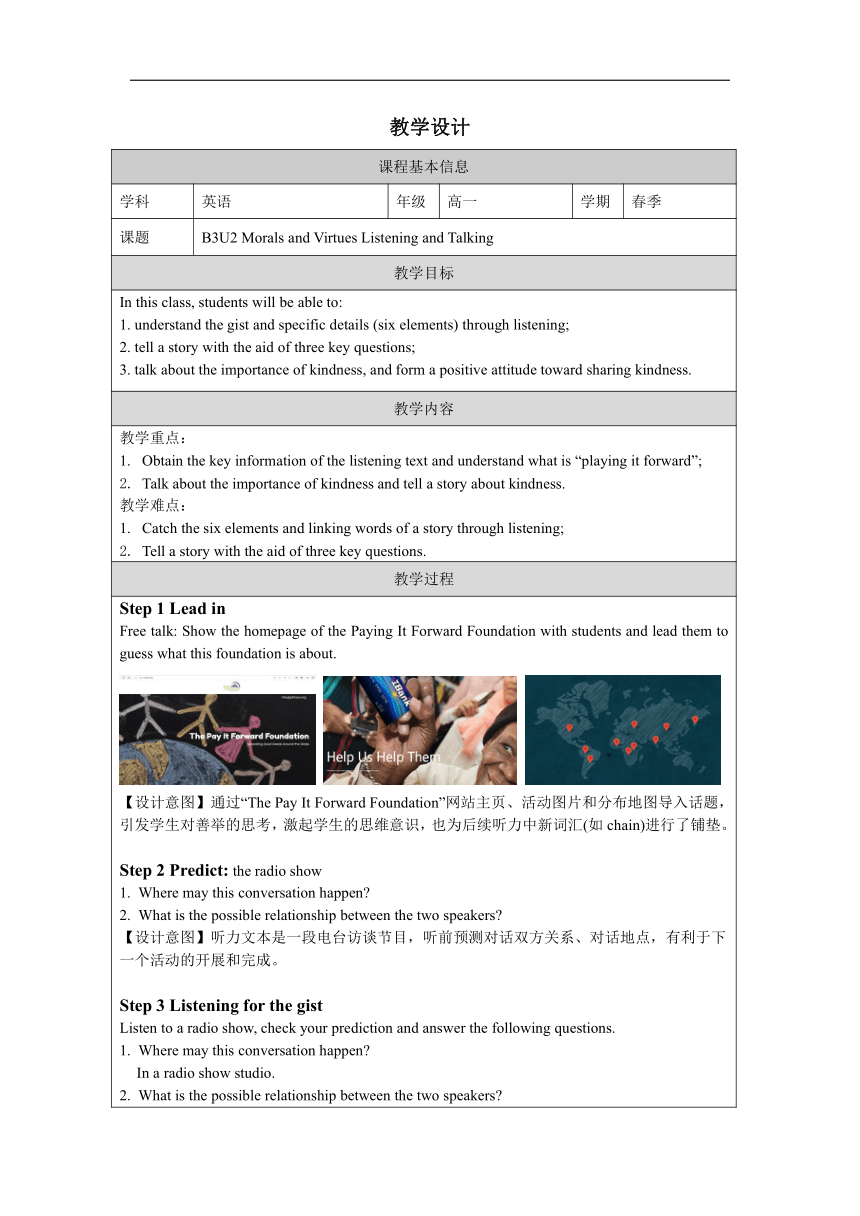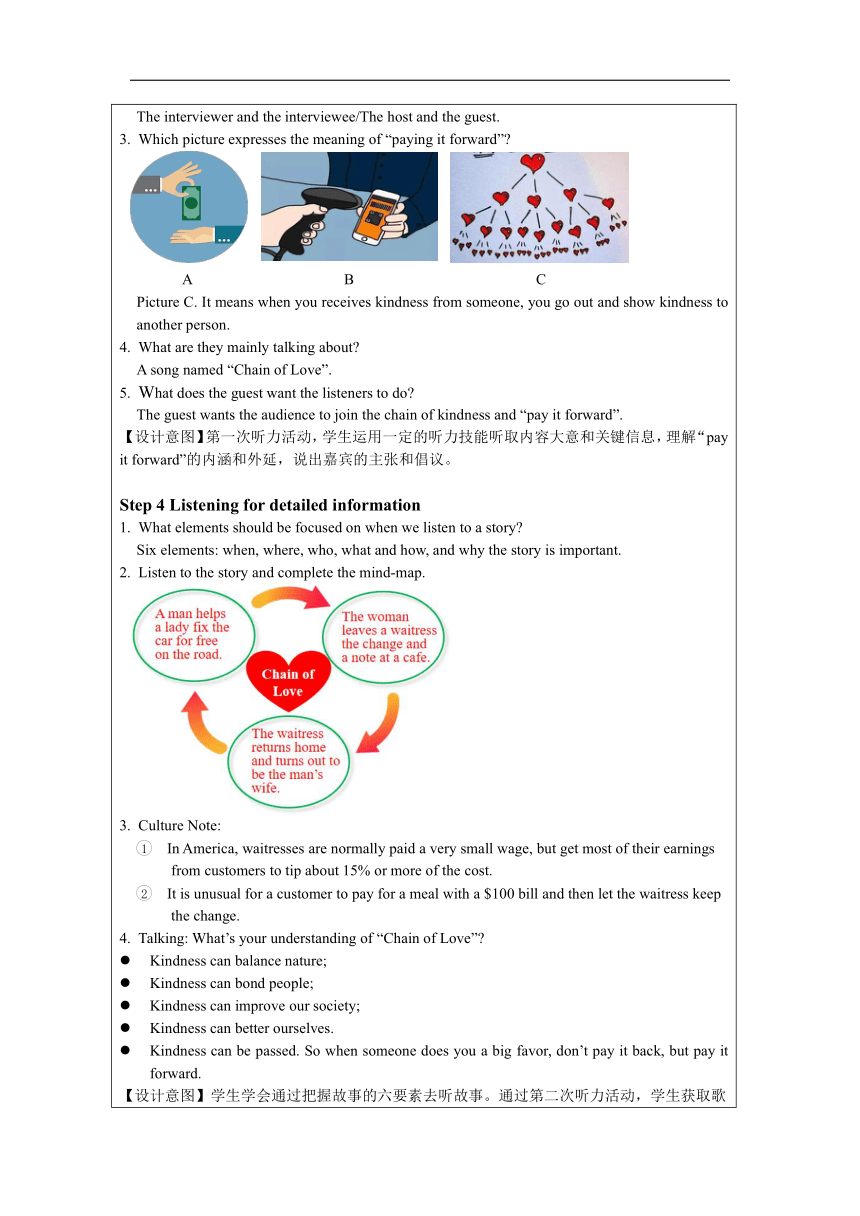人教版(2019)必修第三册 Unit 2 Morals and Virtues Listening and Talking-教学设计(表格式)
文档属性
| 名称 | 人教版(2019)必修第三册 Unit 2 Morals and Virtues Listening and Talking-教学设计(表格式) |

|
|
| 格式 | docx | ||
| 文件大小 | 636.2KB | ||
| 资源类型 | 教案 | ||
| 版本资源 | 人教版(2019) | ||
| 科目 | 英语 | ||
| 更新时间 | 2024-04-04 10:37:00 | ||
图片预览


文档简介
教学设计
课程基本信息
学科 英语 年级 高一 学期 春季
课题 B3U2 Morals and Virtues Listening and Talking
教学目标
In this class, students will be able to: 1. understand the gist and specific details (six elements) through listening; 2. tell a story with the aid of three key questions; 3. talk about the importance of kindness, and form a positive attitude toward sharing kindness.
教学内容
教学重点: Obtain the key information of the listening text and understand what is “playing it forward”; Talk about the importance of kindness and tell a story about kindness.
教学难点: Catch the six elements and linking words of a story through listening; Tell a story with the aid of three key questions.
教学过程
Step 1 Lead in Free talk: Show the homepage of the Paying It Forward Foundation with students and lead them to guess what this foundation is about. 【设计意图】通过“The Pay It Forward Foundation”网站主页、活动图片和分布地图导入话题,引发学生对善举的思考,激起学生的思维意识,也为后续听力中新词汇(如chain)进行了铺垫。 Step 2 Predict: the radio show Where may this conversation happen What is the possible relationship between the two speakers 【设计意图】听力文本是一段电台访谈节目,听前预测对话双方关系、对话地点,有利于下一个活动的开展和完成。 Step 3 Listening for the gist Listen to a radio show, check your prediction and answer the following questions. Where may this conversation happen In a radio show studio. What is the possible relationship between the two speakers The interviewer and the interviewee/The host and the guest. Which picture expresses the meaning of “paying it forward” A B C Picture C. It means when you receives kindness from someone, you go out and show kindness to another person. What are they mainly talking about A song named “Chain of Love”. What does the guest want the listeners to do The guest wants the audience to join the chain of kindness and “pay it forward”. 【设计意图】第一次听力活动,学生运用一定的听力技能听取内容大意和关键信息,理解“pay it forward”的内涵和外延,说出嘉宾的主张和倡议。 Step 4 Listening for detailed information What elements should be focused on when we listen to a story Six elements: when, where, who, what and how, and why the story is important. Listen to the story and complete the mind-map. Culture Note: In America, waitresses are normally paid a very small wage, but get most of their earnings from customers to tip about 15% or more of the cost. It is unusual for a customer to pay for a meal with a $100 bill and then let the waitress keep the change. Talking: What’s your understanding of “Chain of Love” Kindness can balance nature; Kindness can bond people; Kindness can improve our society; Kindness can better ourselves. Kindness can be passed. So when someone does you a big favor, don’t pay it back, but pay it forward. 【设计意图】学生学会通过把握故事的六要素去听故事。通过第二次听力活动,学生获取歌曲“Chain of Love”的细节信息,完成思维导图,并谈论友善的重要性。不仅提高学生获取信息的能力,而且让学生了解文化背景,感受到小小善举的重大意义。 Step 5 Listening for linking words Listen to the story again and take down the linking words. The linking words include: but, instead / late, when, then / then. Thinking: What makes it a smooth story For one thing, the story develops step by step; for another, linking words make it smooth and logical. Brainstorm for more linking words and expressions. Linking Words: once upon a time, long ago first of all, then, after that, later, finally so, however, although, but Useful Expressions: I remember this happened when I was... I was on my way to... I was sitting... when... It was a...day/morning... There were... on the street... 【设计意图】会听故事在英语学习中起到非常重要的作用。第三次听力活动,引导学生从听力文本中找出可用于叙述故事的衔接词和句式,理解其语言功能,为学生提供了开场白、叙事逻辑和时态上的指引。并通过头脑风暴思考更多的衔接词和句式,为后面的口头表达做好准备。 Step 6 How to tell a story How can we tell a story What is the story about (Background: when, where, who) How is the story developed (correct tenses) (step by step) (use linking words) Why is it important to you Why do you remember it Share your story of showing or receiving kindness. Teacher’s example: Last weekend, I walked up to the store as usual. But when it was my turn to pay for my groceries, I found myself short about ten yuan. I was about to take off things I could do without, when a stranger handed me a ten-yuan note, smiling. At that time, I, who am never speechless, was speechless. I asked for the man’s name and address so that I could repay him. However, he said I should just regard it as his gift for me. I was so touched by his gesture that I decided to pay it forward. If the same happened to someone else, I would definitely pay for him/her. So, whoever you are, thank you for the random act of kindness that not only has helped me out, but has made my day. 【设计意图】教师提供给学生讲故事的策略,帮助学生理清思路,知道故事从那哪个方面讲以及怎么去讲,策略的学习有助于提高学习效率。教师示范,学生模仿输出,讲述发生在自己身边的爱心故事。 Step 7 Critical thinking As a teenager, what can we do to spread kindness Small acts of kindness can make a big difference. So we can join the chain of kindness and pay it forward to make this world better. Reflect on what you’ve learned in this class, and send a message to the Pay It Forward Foundation. 【设计意图】学生对于“爱心链”这一故事的理解和探讨,既培养其听说能力,还升华主题,渗透了人生观和道德观的培养。通过批判性思维活动,学生会意识到一次小的善举能给人带来意想不到的温暖和光亮;并通过自己的善行去影响他人,就能创造更美好的社会氛围。 Step 8 Theme conclusion (Confucius) Don't miss doing any good thing no matter how insignificant it looks. (William Wordsworth) The best portion of a good man’s life is his little, nameless, unremembered acts of kindness and of love. 【设计意图】通过名人引言,让学生明白,善举不分大小,善举温暖心灵,善举润物无声,体现在平凡生活的点滴之中,只有用心体会,才能发现道德和美德在社会生活中不可忽视的力量。升华主题,传递爱心,塑造学生的美好品格。 Step 9 Homework View a public service announcement “One Day”(见配套学习资源推荐) and write a story of sharing or receiving kindness. Here are some words and expressions that may help you. Outline When:________ Where:_______ Who:_________ What and how:___________ Why is the story important:_ Linking words:___________Linking Words once upon a time, long ago first of all, then, after that, later, finally so, however, although, but Useful Expressions I remember this happened when I was... I was on my way to... I was sitting... when... It was a...day/morning... There were... on the street...
【设计意图】鼓励学生运用课堂中所学词汇和句式,充分发挥想象力和创造力,讲述自己的故事或公益广告“One Day”中的一个故事。讲故事也是培养学生表达能力的一种有效方式;更重要的是,讲故事可以把学生已有的知识、生活经验和所学内容结合起来,有助于探究主题意义,发展学生的素养。
课程基本信息
学科 英语 年级 高一 学期 春季
课题 B3U2 Morals and Virtues Listening and Talking
教学目标
In this class, students will be able to: 1. understand the gist and specific details (six elements) through listening; 2. tell a story with the aid of three key questions; 3. talk about the importance of kindness, and form a positive attitude toward sharing kindness.
教学内容
教学重点: Obtain the key information of the listening text and understand what is “playing it forward”; Talk about the importance of kindness and tell a story about kindness.
教学难点: Catch the six elements and linking words of a story through listening; Tell a story with the aid of three key questions.
教学过程
Step 1 Lead in Free talk: Show the homepage of the Paying It Forward Foundation with students and lead them to guess what this foundation is about. 【设计意图】通过“The Pay It Forward Foundation”网站主页、活动图片和分布地图导入话题,引发学生对善举的思考,激起学生的思维意识,也为后续听力中新词汇(如chain)进行了铺垫。 Step 2 Predict: the radio show Where may this conversation happen What is the possible relationship between the two speakers 【设计意图】听力文本是一段电台访谈节目,听前预测对话双方关系、对话地点,有利于下一个活动的开展和完成。 Step 3 Listening for the gist Listen to a radio show, check your prediction and answer the following questions. Where may this conversation happen In a radio show studio. What is the possible relationship between the two speakers The interviewer and the interviewee/The host and the guest. Which picture expresses the meaning of “paying it forward” A B C Picture C. It means when you receives kindness from someone, you go out and show kindness to another person. What are they mainly talking about A song named “Chain of Love”. What does the guest want the listeners to do The guest wants the audience to join the chain of kindness and “pay it forward”. 【设计意图】第一次听力活动,学生运用一定的听力技能听取内容大意和关键信息,理解“pay it forward”的内涵和外延,说出嘉宾的主张和倡议。 Step 4 Listening for detailed information What elements should be focused on when we listen to a story Six elements: when, where, who, what and how, and why the story is important. Listen to the story and complete the mind-map. Culture Note: In America, waitresses are normally paid a very small wage, but get most of their earnings from customers to tip about 15% or more of the cost. It is unusual for a customer to pay for a meal with a $100 bill and then let the waitress keep the change. Talking: What’s your understanding of “Chain of Love” Kindness can balance nature; Kindness can bond people; Kindness can improve our society; Kindness can better ourselves. Kindness can be passed. So when someone does you a big favor, don’t pay it back, but pay it forward. 【设计意图】学生学会通过把握故事的六要素去听故事。通过第二次听力活动,学生获取歌曲“Chain of Love”的细节信息,完成思维导图,并谈论友善的重要性。不仅提高学生获取信息的能力,而且让学生了解文化背景,感受到小小善举的重大意义。 Step 5 Listening for linking words Listen to the story again and take down the linking words. The linking words include: but, instead / late, when, then / then. Thinking: What makes it a smooth story For one thing, the story develops step by step; for another, linking words make it smooth and logical. Brainstorm for more linking words and expressions. Linking Words: once upon a time, long ago first of all, then, after that, later, finally so, however, although, but Useful Expressions: I remember this happened when I was... I was on my way to... I was sitting... when... It was a...day/morning... There were... on the street... 【设计意图】会听故事在英语学习中起到非常重要的作用。第三次听力活动,引导学生从听力文本中找出可用于叙述故事的衔接词和句式,理解其语言功能,为学生提供了开场白、叙事逻辑和时态上的指引。并通过头脑风暴思考更多的衔接词和句式,为后面的口头表达做好准备。 Step 6 How to tell a story How can we tell a story What is the story about (Background: when, where, who) How is the story developed (correct tenses) (step by step) (use linking words) Why is it important to you Why do you remember it Share your story of showing or receiving kindness. Teacher’s example: Last weekend, I walked up to the store as usual. But when it was my turn to pay for my groceries, I found myself short about ten yuan. I was about to take off things I could do without, when a stranger handed me a ten-yuan note, smiling. At that time, I, who am never speechless, was speechless. I asked for the man’s name and address so that I could repay him. However, he said I should just regard it as his gift for me. I was so touched by his gesture that I decided to pay it forward. If the same happened to someone else, I would definitely pay for him/her. So, whoever you are, thank you for the random act of kindness that not only has helped me out, but has made my day. 【设计意图】教师提供给学生讲故事的策略,帮助学生理清思路,知道故事从那哪个方面讲以及怎么去讲,策略的学习有助于提高学习效率。教师示范,学生模仿输出,讲述发生在自己身边的爱心故事。 Step 7 Critical thinking As a teenager, what can we do to spread kindness Small acts of kindness can make a big difference. So we can join the chain of kindness and pay it forward to make this world better. Reflect on what you’ve learned in this class, and send a message to the Pay It Forward Foundation. 【设计意图】学生对于“爱心链”这一故事的理解和探讨,既培养其听说能力,还升华主题,渗透了人生观和道德观的培养。通过批判性思维活动,学生会意识到一次小的善举能给人带来意想不到的温暖和光亮;并通过自己的善行去影响他人,就能创造更美好的社会氛围。 Step 8 Theme conclusion (Confucius) Don't miss doing any good thing no matter how insignificant it looks. (William Wordsworth) The best portion of a good man’s life is his little, nameless, unremembered acts of kindness and of love. 【设计意图】通过名人引言,让学生明白,善举不分大小,善举温暖心灵,善举润物无声,体现在平凡生活的点滴之中,只有用心体会,才能发现道德和美德在社会生活中不可忽视的力量。升华主题,传递爱心,塑造学生的美好品格。 Step 9 Homework View a public service announcement “One Day”(见配套学习资源推荐) and write a story of sharing or receiving kindness. Here are some words and expressions that may help you. Outline When:________ Where:_______ Who:_________ What and how:___________ Why is the story important:_ Linking words:___________Linking Words once upon a time, long ago first of all, then, after that, later, finally so, however, although, but Useful Expressions I remember this happened when I was... I was on my way to... I was sitting... when... It was a...day/morning... There were... on the street...
【设计意图】鼓励学生运用课堂中所学词汇和句式,充分发挥想象力和创造力,讲述自己的故事或公益广告“One Day”中的一个故事。讲故事也是培养学生表达能力的一种有效方式;更重要的是,讲故事可以把学生已有的知识、生活经验和所学内容结合起来,有助于探究主题意义,发展学生的素养。
